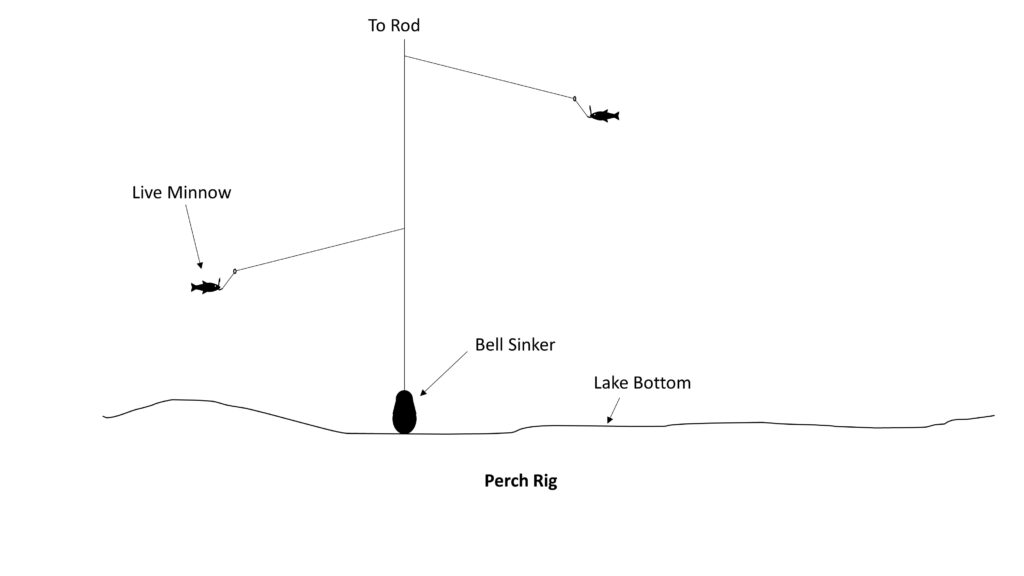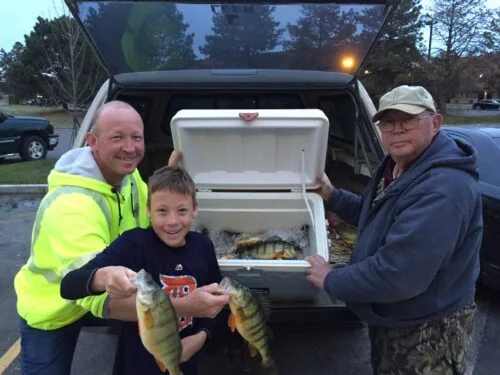How to Catch Yellow Perch on the Great Lakes

* This page contains affiliate links. The Great Lakes Fisherman may earn a commission on items purchased through these links. For more on this, please click here.
Yellow Perch (Perca flavescens) are a favorite table fare of fish connoisseurs. Their mild taste and firm texture make them perfect for cooking just about any way you’d like. They are also a great fish to target for families. This is because the action can often be fast and furious, leaving little time for boredom for the younger or less serious anglers. Lucky for anglers in the Midwest, they are also one of the most abundant game fish in the Great Lakes and can be caught year round. But how do you go about finding and catching these tasty critters? Here, we will discuss how to catch yellow perch on the Great Lakes.
The Gear
Perch fishing doesn’t require a lot of fancy equipment. A simple spinning rod and reel will do in most cases. However, the guide below will provide you with the detail necessary to put more fish in the cooler.
The Rod
A medium-light to medium action, 5.5′-7.5′ spinning rod with an appropriately paired spinning reel will work just fine for most perch fishing in waters up to 30′ deep. When the fish get deeper than 30′, the bite will be harder and harder to detect, prompting many to switch to longer, more sensitive rods. Some perch fisherman use rods as long as 10′ or more in deep water. This is because the tip movement is more pronounced on these rods, making the bite easier to detect.
The Line
Perch are not line shy. This means that generally speaking, any type of fishing line will work. That doesn’t mean that some lines aren’t better than others. Each type of fishing line will stretch to a different degree and too much line stretch make a perch bite harder to detect. In shallower waters, monofilament and flourocarbon work great. However, both of these lines have some stretch and when the bite is light or when fishing in deep water, the less stretch the better. In these situations, braided line works best as it has virtually no stretch and will pick up the slightest bump on the line. This telegraphs a bite very well in deep water. If you are concerned about line visibility, you can always add a flourocarbon leader to your braided line before tying on the perch rig.
The Rig and Bait
The most common bait used for catching yellow perch is live minnows. These are placed on hooks that are attached to a weighted line (be sure to check local fishing regulations for information on the number of hooks allowed per line in your jurisdiction). For beginning perch anglers, a “perch spreader” or “perch rig” can be purchased online or at your local great lakes tackle shop. These provide the entire setup needed with the exception of the bell sinker. These rigs involve arms with hooks that are cantilevered off of the main line. They are not expensive, going for just a few dollars each. (Tip: Hooking the minnow through the bottom jaw and nose will allow it to swim more freely and not die as quickly.)
When using these rigs, simply tie the top of the rig to your main line (some have pre-tied loops or swivels for easier attachment. Then just add a bell sinker to the bottom of the rig. For the bell sinker, choose the lightest weight that will ensure that the rig stays on the bottom. This will be dictated by depth, water current and wind/wave conditions. Bell sinkers from 1/2 oz to 1 oz are the most common.

[ADDED 2/10/23: For an easy, do-it-yourself version of the perch rig, check out this video. We actually prefer these to the store-bought version as we find them more versatile, cheaper and more sensitive to the bite. If, after watching the video, you have any questions on how to tie these up, please drop us an email and we’d be happy to help.]
Locating Yellow Perch
Great Lakes perch tend to spend their time close to the lake bottoms in waters that are less than 30 feet deep, although they can be found in depths of up to 100 feet or more. They wander in schools foraging for food while finding safety in numbers. To find out where there are fishable numbers, simply follow these three steps.
Step 1: Check Fishing Reports to Find Which Ports in Your Area Have Active Fish
The best way to locate the general areas of the lakes that have an active perch bite is to browse local fishing reports. Schools of perch tend to be found in certain waters in different times of the year. Like many fish, perch tend to spend the hot summer months in deeper water than during the cooler months. Fall, winter and spring they can often be found in shallower water near weed beds. Checking local reports will give you the best indication of which port(s) to focus on at the time you plan to fish.
Step 2: Look for Clusters of Anchored Boats
Step one has given you a lead on a port to launch from. But the Great Lakes are huge and your work is not done yet. Once you are out on the lake, look for clusters of boats that appear to be anchored. Most people catch perch by anchoring their boats and fishing over individual schools. By locating a cluster of anchored boats, you are giving yourself a head start on locating some hungry fish. This doesn’t mean that this is the only place you’ll find perch. But it certainly can help quicken the search.
Step 3: Use Your Sonar to Locate Individual Schools of Fish
Whether or not you were able to find a boat cluster, this step is critical to finding fish. Most modern sonar units are sensitive enough to mark fish on or near the bottom. What you are looking for are small separations from the bottom. For this, it is recommended to not rely on your fish-finder’s fish alarms or symbols, but instead, decipher the marks yourself. When you start seeing a lot of small squiggly marks or arches right near the bottom, you have likely located a school of perch.
Catching Yellow Perch
Now that you are rigged up, it’s time to catch some perch. Anchoring the boat is the most common way to fish for perch because the schools are typically large enough to keep you busy in one location. There are anglers who will drift for perch to locate them. This is actually a common practice in areas of the Great Lakes where the schools are more scattered and weeds are not prevalent enough to become a snag nuisance. Nonetheless, most fisherman will anchor.

Once you have located a school of fish on the sonar, pull your boat directly upwind from that spot by the same distance that you expect your anchor line to take up. For example, if you are fishing in 20′ of water and based on the wind, you expect to need 100′ of anchor rope to hold you, pull your boat about 100′ upwind from the spot you marked the school. From there let out your anchor rope and watch your sonar. Once you have let out enough rope to hold the boat, continue letting out additional rope until you see the fish re-appear on your sonar. While it may sound difficult to do, you will typically have a lot of leeway as the schools tend to be quite large. Once the boat is anchored over the school, it’s time to drop lines!
Drop the weighted rig into the water and let out line until it stops pulling line off of the reel. This indicates that the weight has hit the bottom. Next, reel up the slack line until the line is just tight, but DO NOT pull the weight off of the bottom. Hold the rod to where the line is tight but the rod tip is not loaded or bent. This is the perfect position for feeling a bite. If the rod is loading up there, is a good chance that you are actually lifting the weight off of the bottom, lessening the chances of a bite. If your line is slack, you will often not feel the bite or feel it after the fish has completely swallowed the hook.
Once your line is set, just hold the rod still and watch the tip of the rod. If the bite is heavy, you will likely see the rod tip move and feel the bite through the rod. If it is very light, you may only notice a slight deviation in the rod tip and not feel anything at all. Either way, once you detect the bite, pull up swiftly by pivoting your wrist back towards you while lifting your arm upwards. This combined action will set the hook the fastest and will increase the number of hook-ups. Once the hook is set, simply reel in dinner. As always, be sure to check your regulations for creel limits.
